How to Convert the OH into a Leaving Group
In many cases, when students are asked to convert an alcohol to an alkyl halide, they would use the corresponding halide and show the reaction with an SN2 mechanism:
The result is getting no points or partial credit if you get lucky. The reason for this is that the hydroxyl ion (–OH) is a poor leaving group which, in other words, means it is very reactive and even if it were to form, it would react with the other product of the reaction and shift the equilibrium back to the original state.
This would also be true for a hypothetical SN1 mechanism even if we have a 3° alcohol.
The bottom line: OH cannot depart by itself and cannot be kicked out by a nucleophile.
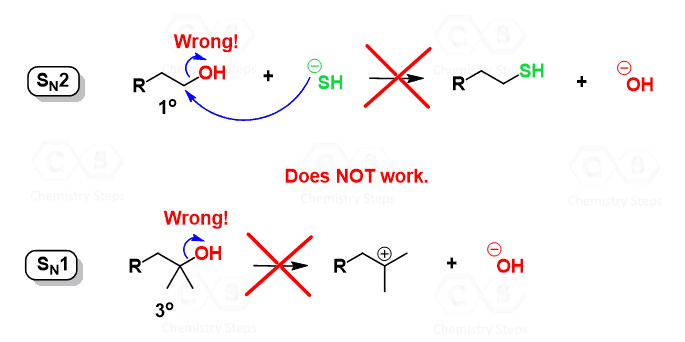
In order to get rid of the OH group, you need to convert it to a good leaving group! There are two main approaches to this:
1) Treat the alcohol (the OH group) with HCl, HBr, or HI and covert the OH group to H2O+ which is an excellent leaving group and can undergo an SN1 or SN2 substitution by the halide ion (Cl–, Br–, or I–).
2) Activate the OH group with sulfonyl chlorides such as p-Toluenesulfonyl chloride, Methanesulfonyl chloride, and Trifluoromethanesulfonyl chloride by converting it to a Tosylate (-OTs), Mesylate (-OMs) and Triflate (-OTf) respectively and react it further with a nucleophile. Or, treat the alcohol with Thionyl chloride (SOCl2), Phosphorus tribromide (PBr3), ZnCl2, etc. to convert to the corresponding alkyl halide.
This looks like a lot of reagents but they all have the same idea of turning the OH into a good leaving group and a somewhat similar mechanism, so once you understand the principle, you can apply it for different reactions.
The figure below shows the two main approaches with acids on the left and other activators on the right side.

Approach 1: Conversion of Alcohols to Alkyl Halides with HX
Both, the substrate and the acid affect the conversion in the following way:
1) The strength/reactivity of the acid, hence the efficiency of the conversion is increasing in the following order:
HCl < HBr < HI
2) More substituted alcohols usually react more rapidly with HX:
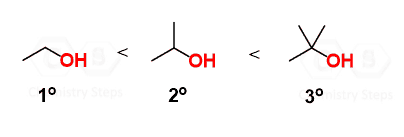
Methyl and primary alcohols are converted to alkyl halides via SN2 reaction according to the general mechanism shown below. The I– and Br– are strong enough nucleophiles to attack the primary carbon and the +OH2, in turn, is an excellent leaving group in form of neutral water molecule. HCl is the weakest acid among these and Cl– is not a strong nucleophile so the reaction with HCl is not as efficient and sometimes requires an additional catalyst like ZnCl2. Check with your instructor for more details.
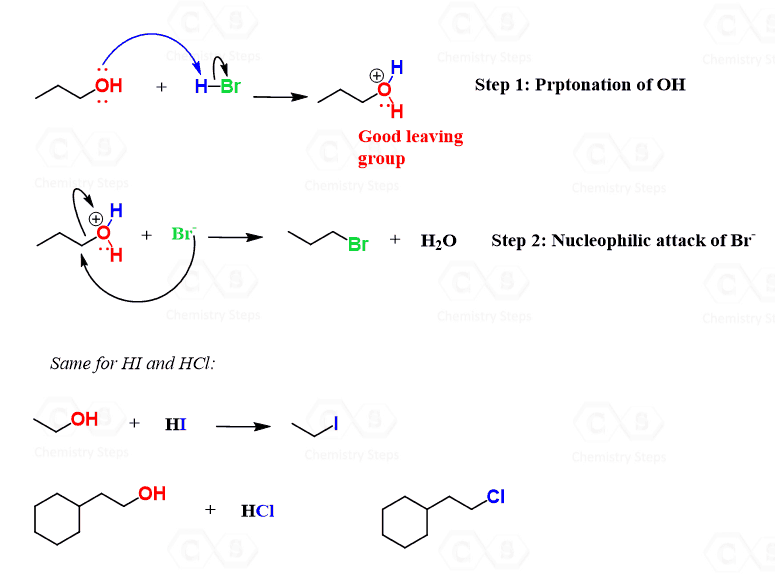
Secondary alcohols can undergo SN2 and SN1 reactions with SN1 being the predominant pathway, so if you want to have control over the stereochemistry of the reaction, the second approach, which we will discuss in more detail below, will definitely be more beneficial.

Keep in mind the possibility of rearrangements in SN1 reactions which is one reason why the SN1 pathway predominates in 2° and 3° alcohols:
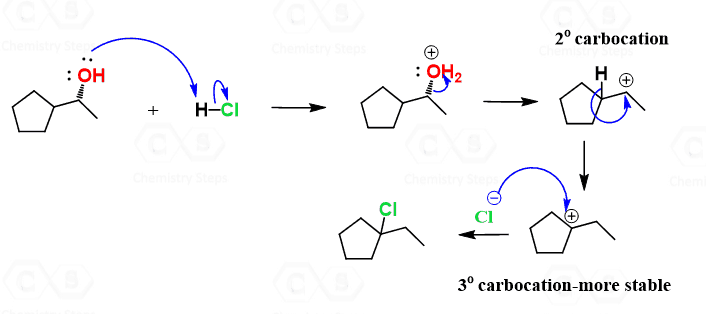
To summarize, yes, alcohols can be converted to alkyl halides in acidic conditions. However, there are two main disadvantages:
1) The strong acidic conditions are often not suitable for organic molecules.
2) The SN1 mechanism lacks the stereochemical control and rearrangements add another liability as the regiochemical outcome of the reaction. The methods described in “Approach 2” address these important issues and allow to achieve the desired transformations under milder conditions.
Approach 2: Activating the OH with other functional groups
1) Tosylates and Mesylates
Tosylates and Mesylates are prepared by treating alcohols with sulfonyl chlorides in the presence of a base (most often Pyridine or TEA). Notice that the carbon with the stereogenic center is not involved during this step, so the absolute configuration is retained in the resulting tosylate:
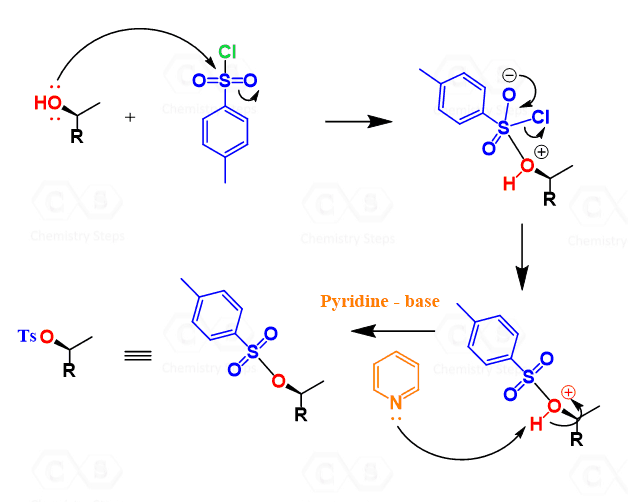
Mesylation goes with a slightly different mechanism. The first step here is the abstraction of the acidic ɑ proton from methanesulfonyl chloride. However, as for the tosylation, the chirality of the alcohol is retained.
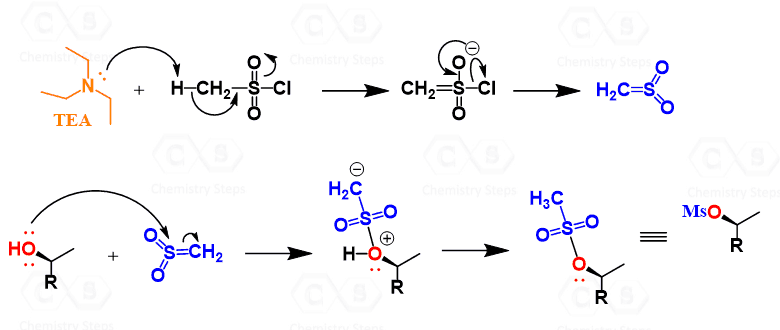
Ask your instructor if the same mechanism as for tosylation is acceptable for mesylation.
Both of these transform the OH group to a sulfonate which is a very good leaving group as a result of having three oxygens handle the negative charge vs one oxygen in the hydroxyl group.
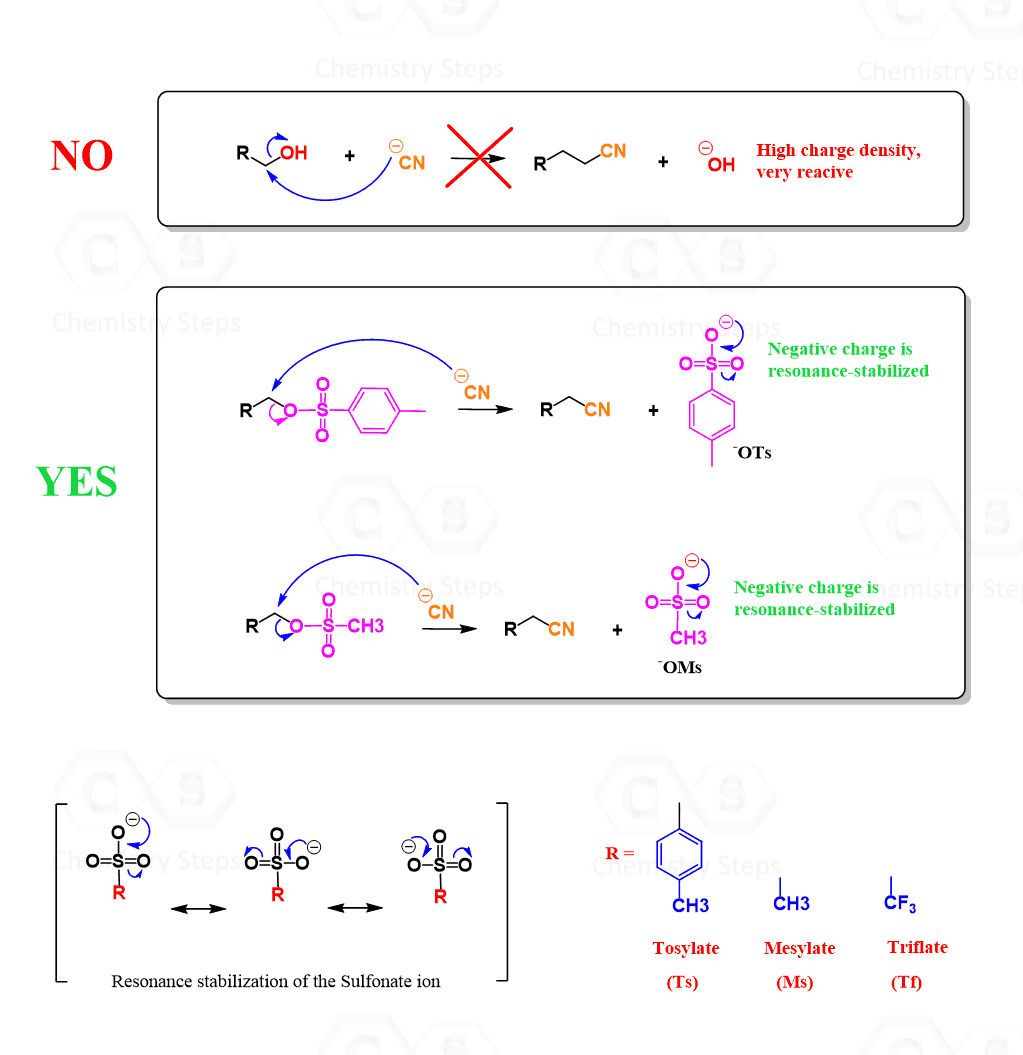
Alkyl sulfonates are a better alternative to HX acids and allow us to control the stereochemistry of SN2 substitution reactions on secondary alcohols. Some more examples are shown below and in the practice exercises.
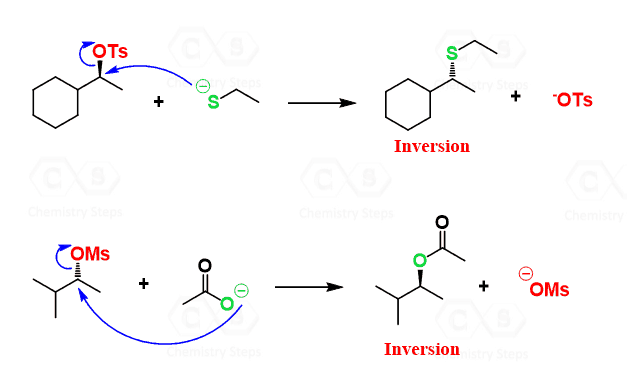
Another advantage of mesylates and tosylates is the milder conditions and a broader range of nucleophiles that we can use, while HX acids are restricted to the corresponding halide ion as the nucleophile.
Tosylates and Mesylates can also undergo SN1 and elimination reactions under right conditions.

2) Conversion of Alcohols to Alkyl Halides with SOCl2 and PBr3
Thionyl chloride (SOCl2) is another great alternative to the HX acids that convert 1° and 2° alcohols to their corresponding alkyl chlorides with inverted chirality. Like for the sulfonyl chlorides, the first step is converting the OH into a good leaving group after which the chloride attacks via an SN2 reaction:

The pyridine is added to ensure the inversion of the stereogenic center via the SN2 mechanism. If pyridine is not present, the reaction tends to go via SNi (nucleophilic substitution with internal return) mechanism.
In some literature, it is mentioned that SOCl2 can convert 3° alcohols as well. Ask your instructor if that would be acceptable.
In a similar reaction, phosphorus tribromide, PBr3, is used to convert 1° and 2° alcohols to their corresponding alkyl bromides with inverted chirality:







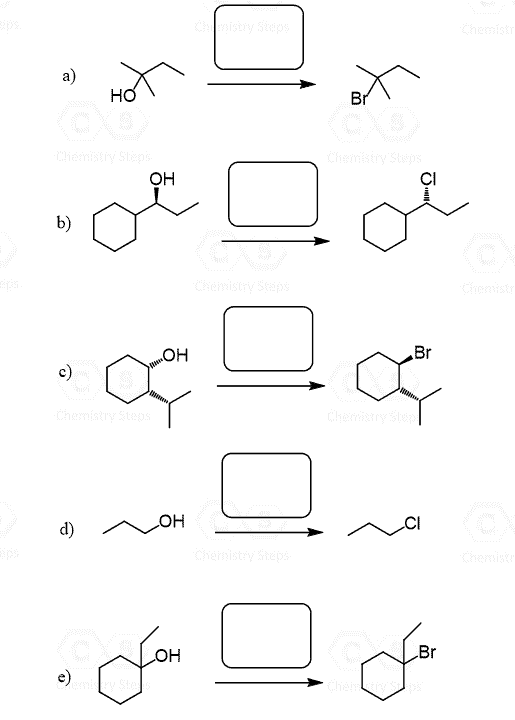
Hi, I love solving all the problems here,
I have a doubt though. In segment 2 why is there an attachment of ch3o to the product in question 1 whereas only OH attaches to the product in question 5?
Hello,
Are asking about the reaction of OTs with ethanol? If yes, then it is EtO- and not CH3O- in the product. Alcohols give ethers in substitution reactions while waters produces an alcohol.
Ok; thank y’a
Hi, sorry. i mean question 6*.